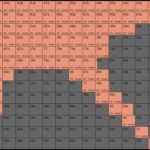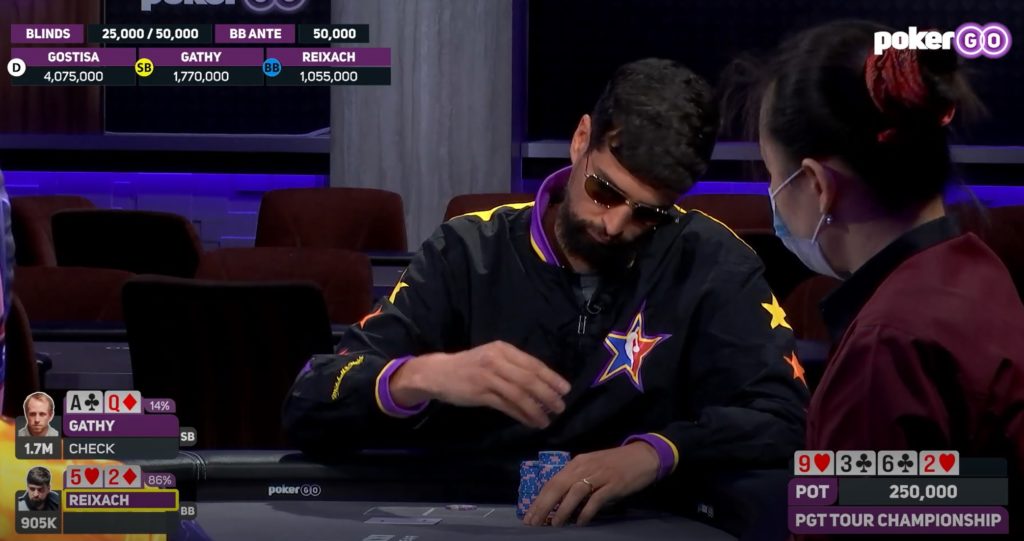
Bluffing in poker is when you bet or raise in an attempt to make your opponent fold a better hand. If your opponent folds you'll be awarded the pot by default. This gives you two ways to win the pot in poker, either by having the best hand or by successfully bluffing.
Bluffing is best learned by understanding the interaction between players' ranges and the value-bet-to-bluff-ratio.
Thankfully, bluffing is an easy skill to learn by adhering to the 3 rules of efficient bluffing and studying some GTO solver solutions.
Easy to learn, hard to master!
In this article, we'll take you through everything you need to know about bluffing to set you on your way to being a bluffing master!
Let's dive into some bluffing strategy!
Players are doing a lot of bluffing!
Most bluffs you see or hear about are big river bluffs but buffing comes in all shapes and sizes.
Although we generally don't think of it this way, bluffing is something that starts with preflop raises, even when first in the pot. The typical opening range will contain strong hands like aces, but then also marginal hands like 67s or 9To depending on where we are sitting around the table (check out our free preflop ranges if you aren't using a guide already when entering the pot first).
If we raise a hand like 6♣7♣ and steal the blinds, did we just bluff?
Inevitably, opponents would have folded hands with better raw equity. Some may even have had us dominated, such as when they fold Q♣6♦, etc.
Next, we'll often miss the flop and have the decision of whether we want to c-bet or not. This is really where the separation between poor and competent players begins.
Thinking About Hand Ranges

Competent players always consider the range of hands they can be holding. This allows them to play far superior over a player who is still stuck only thinking about the two hole cards in front of them.
By thinking about their range of hands, competent players can devise (or may even have memorized) an effective strategy on the flop. Splitting their range between the hands they want to check and c-bet. Then additionally, the size to bet, or sizes if multiple bet sizes seem preferable for the situation (if you want to know more about bet sizing here's one of our popular articles called How to Find the Right Bet Size Post-flop – The 3 Step Guide.
This allows the player to execute a long-term GTO-oriented winning strategy. Alternatively, they may wish to deviate from GTO at times to exploit a particular opponent they are up against.
At all but the lowest levels online, this is the process most players are going through at the table. Furthermore, they're also aware that there are still future streets of play that need to be accounted for.
Have a Plan (value-bet-to-bluff-ratio)
On the flop with multiple cards to come and plenty of decision points left, we can be more liberal with our betting and include some more marginal hands. So we'll be betting higher equity hands for value, lower equity hands as a bluff or semi-bluff, and then potentially even some more merged hands so we aren't predictable. All of this of course will depend on the flop texture, but basically, this is the process frequently going on.
Thinking about the turn, in order to leave ourselves with the right amount of strategic options we generally bet a 2:1 ratio between bluff bets and value bets on the flop.
Then on the turn, this will shift to a 1:1 ratio. Finally, by the river, around a 2:1 ratio of value bets to bluffs is used but it all depends on river bet sizing.
Planning Allows Us More Manuevreability When Bluffing

By planning the hand in this way it allows us to arrive at the river with the right balance of hands. Therefore avoiding what happens to a lot of player's which is having a vulnerable overly strong, or, weak range. Vulnerable in the sense that players will be able to easily figure out the situation and make clearly profitable decisions.
Common adjustments include folding more when a range is overly strong or attacking a range when it is capped.
Notice if a pot was $100 and we made a pot size bet of $100 our opponent would be getting 2-to-1. That is, they would need to call $100 to win $200. This requires them to win the pot at least 33% of the time or else they are losing money.
Now consider the ratio of our range and you can see we've created a kind of break-even scenario for our opponent. A 2-to-1 value to bluff ratio. Leading to our opponent needing to win the pot 1 out of 3 times (presumably the time we are bluffing).
This brings us to the concept of indifference. If Lucy flips a coin and offers to pay Gary $1 if it's heads but hand over $1 if it's tails, neither player has an edge.
Now suppose Lucy manages to negotiate $1.10 when it's heads. In this case, she's established an edge and will certainly win over time. A simple example of the essence of poker when we're using a superior strategy.
Betting Frequency
In reality, given all the variables and the complex nature of the game, things rarely work out precisely in the heat of battle. Moreover, we have to consider the players' ranges and board texture and so finding the right frequencies to bet can be difficult.
As a rule of thumb, consider the number of value hands you have that want to bet. Counting combinations is a good way to do this and is really easy when you get the hang of it - Here's a tutorial to teach those who aren't familiar with it.
[embedyt] https://www.youtube.com/watch?v=gShunRSRzs4[/embedyt]In a situation where you decide you have roughly 30-40 value betting hands, you can then go for 15-20 bluffing combinations as this adheres to the 2:1 value-bet-to-bluff ratio. However, you would alter this depending on your bet size and possibly if there are any exploitative considerations too.
This is not an exact science so for those new to this concept don't worry. Additionally, it becomes fairly automatic once you adopt the right thought process throughout the hand.
The sorts of hands to bluff bet with will often stand out thanks to the 3 rules of efficient bluffing.
Thankfully, when it comes to selecting which hands to bluff with, the 3 rules of efficient bluffing make this process relatively easy!
Picking the Best Hands to Bluff
The 3 rules of efficient bluffing provide a simple, logical approach to finding the best bluff combinations in our range.
Never wonder what hands to bluff with again!
THE THREE RULES OF EFFICIENT BLUFFING
- Betting will fold out superior holdings
- The combination has some backdoor potential to become strong
- Blocks parts of villains continuing range
Betting Will Fold Out Superior Hands (The Objective of Bluffing)
The first rule of efficient bluffing is the basic objective of why we bluff. We want to make a better hand fold. Still, we can do even better than this when we bluff bet. Not only do we want to make better hands fold, but we also want to make our opponent make as large a mistake as possible.
Maximize your bluffs efficiency!
For example, on a Q♥7♦2♠ flop, if we bet 8♠ 9♠ and our opponent folds, that's great. Our opponent frequently folded a better hand (depending on the situation obviously). Now how about if we bet 3♠ 4♠? In this instance, our opponent definitely folded a better hand because we have the nut low! This means our opponent had even more equity against us and made a bigger mistake. This makes our bluffs even more efficient and sums up the first of the rules.
The Combination has Some Potential to Become the Best Hand
Before the river, a lot of our bluffing range will focus on hands that have ways to improve to be the best hand.
For example, consider the hands mentioned in rule 1, that is, 3♠ 4♠ and 8♠ 9♠ on a Q♥7♦2♠ flop. Both hands can make straights and depending on the suits, sometimes backdoor flushes as well.
Using these types of holdings rather than something like 9♣ 3♦, makes a huge difference over time. That's not to say we won't be making some total airball bluffs, but primarily we'll be utilizing some connectivity and backdoor equity.

The Combination Blocks Parts of Villains Continuing Range
Just like the best value bets don't block parts of our opponent's calling range, the opposite can be said about bluffing.
For example, say UTG raises and we call on the button with A♠ 5♠ . We go to the flop heads-up and facing a c-bet on a K♦7♠ 4♥ flop decide to raise. Notice we block AK and AA which are some of villain's strong hands from UTG.
Breaking this situation down a little further, notice rule 2 is also met in the following ways.
- We have backdoor straight potential
- Aditionally, we have backdoor flush potential
- We hold an overcard which could be good if we hit it
What about rule 1, isn't there more efficient bluffs like 5♥ 6♥?
In regards to rule 1, in this instance, we really have to consider the ranges and the flop texture. Firstly, since players open a tight range from UTG we aren't calling a particularly wide range on the button. We don't have a nice wrap-around combo like 6♥ 8♥.
Secondly, since we're attacking a tighter range here, rules 2 and 3 are critical to the long-term success of the bluff. We really want to have a good blocking effect and backdoor potential. This will more often allow us to multi-street bluff with a decent amount of equity still in our corner.
Now we've worked through some of the key elements of bluffing, let's put it together to see how powerful it is at the tables.
The following hand takes place in the Pokergo Tour Championship with just 3 players left. The action folds to Gathy in the SB with A♣ Q♦. Check out the video review then we'll do some analysis of the decisions.
Hand Breakdown - Gathy vs Reixack
PREFLOP
Preflop the play is standard. Gathy limps holding A♣ Q♦ and Reixack checks the 2♦ 5 ♥ in the BB with a 20bb (M8) stack.
FLOP
Let's take a look at Gathy's then Reixack's decisions on the flop.
Gathy
It's a limped blind vs blind pot with 20bbs effective and the flop comes 9♥ 3♣ 6♣. Let's consider the 3 rules of efficient bluffing with A♣ Q♦ in this spot.
Will bluffing fold-out superior hands?
Buffing won't fold out superior hands so instantly we know we don't have a bluff combination. Should we put this hand in our value betting range? Well to answer that, we need to ask the following question.
Will betting get worse hands to call?
Betting will get some worse hands to call, especially the drawing part of villains range. However, 2 key aspects are at play here that make A♣ Q♦ perfect to put into our checking range.
- There's no clear advantage on this flop, the equities are fairly similar.
- We're out of position so we definitely don't want to bloat the pot with a marginal hand.
It's worth watching the following video which expands upon these principles. It also helps us to understand the situation players are in when facing our bets and bluffs.
Continuing on with our PokerGo hand analysis, A♣ Q♦ can happily check-call most bet sizes and this is the option Gathy goes with, similar to how we saw the solver play the hand.
Big Bet Option
On a final note, it's worth pointing out a small portion of our range that's incentivized to bet does so with a large size. There are two reasons for this.
Firstly, a preflop check-behind range will contain a lot of marginal hands on this flop texture that can be pressured. Including such hands as 6♦ 2♣ or J♥ 3♦ for example. These weakish pair holdings will potentially struggle to get to showdown when facing multiple bets across a lot of board run-outs.
Secondly, we can leverage the fact that we might limp some strong combinations but the IP (in-position) player will rarely check them back. This gives us a slight range advantage in the hand that we can leverage to apply pressure.
Reixack
Repeating the process, consider the 3 rules of efficient bluffing from Reixack's position?
Will better hands fold?
We have close to the stone-cold nut low so better hands will definitely fold!
What's our backdoor potential?
We have a gutshot which is useful but it would be nice to have a backdoor flush, too. Especially when you consider this is a super draw heavy board. There are lots of drawing hands in our range so we can be very choosy with our bluff combinations. If we started betting all our straight and flush draws we'd be massively over-bluffing.
The next and final rule of efficient bluffing is as follows.
What's our blocker value?
We have minimal blocker value as we just block some possible low-end straight drawing combinations.
All in all, we can see this a fairly mediocre hand to bet. I'd be looking to mix it into our semi-bluffing range at a low frequency. Mostly just sticking to the suited combinations that have a backdoor flush.
When it comes to the size to bet, as was discussed in the hand breakdown we'd prefer to go with a size that would put more of our opponent's range in a difficult spot. So betting 2/3-3/4 pot-size seems good given Gathy's equity buckets. This sizing will make it hard for a lot of draws and overcard combinations to profitably continue. Reixack's small 1/3 PSB gives them a fairly easy decision, as was the case here for Gathy.
TURN
Given the flop action and then turn card, Gathy checks in flow. We would never expect Gathy to lead into the flop aggressor in this spot.
Reixack

Interestingly Reixack's hand now picks up a little showdown equity with bottom pair.
If we checked-back the flop, this would be a significant amount of showdown value. Proceeding with another check would allow us to get to the river and likely have the chance to realize our equity.
On the flip side, if we used a large bet size it's questionable how much showdown value the 2♦ 5♥ would have. Larger bets obviously have the effect of narrowing an opponent's range. This leads to the 2♦ 5♥ now potentially being part of a turn semi-bluff range.
Betting it at a frequency is fine but similar to the flop, we do still have a number of bluffs to choose from.
When OOP calls a small 1/3 pot size bet as Reixack made, I'm more in favor of checking-back. Taking our showdown value or chance of making the best hand when we are behind.
RIVER
Gathy

Gathy makes the interesting decision of leading the river with a small 10% block/value bet. In the hand breakdown video, we did see some Axcc that got to the river take this line a small percentage of the time.
Block betting is an important strategy to have in your arsenal (as is donk betting) but the problem is in this instance IP has been showing a lot of strength and we shouldn't really have a lot of Ax getting to the river.
If Gathy is continuing all the time with A♣ Q♦ and A♥ J♣, as well as some other Ax combos that limped the flop, it makes the lead bet a little bit more reasonable.
All in all, it's not bad and probably close to a break-even type of bet here.
Reixeck
If the hand played out in more of a GTO fashion, we could have seen either a check-check on the river or a call versus Gathy's block -bet.
As it was, Reixack took the aggressive route and moved all-in. It's likely Reixack assumed Gathy's range included a lot of middling pair type combinations. These hands would be forced into a difficult spot facing the all-in.
I wasn't a huge fan of the play given Reixacks lack of chips behind. It made it a lot easier for Gathy to flick in the call getting pot odds of around 2:1. Especially given the 'drawy' nature of the board, I find players, in general, have a hard time laying down their hand in such a big pot.
As it was, GTO did make the play at a frequency although it was selective about the suits. Opting to use combinations that would increase the likelihood Gathy was on a flush draw, allowing us to sneak through a few more folds.
HAND CONCLUSION
It's not uncommon to see players, even at a high level, deviate unintentionally from a GTO approach in a hand.
Our 2 players in the reviewed hand did follow some GTO concepts. For example, Gathy did make a 10% river block bet which it's unlikely he would have tried had he never reviewed GTO strategy.
The problem with these strategies is they're often misapplied as we saw. In particular, bet sizing is one of the more difficult aspects to master and even has top pros making regular mistakes.
Implementing an exact GTO style is virtually impossible and shouldn't be your immediate goal. The idea is to simply be playing better than your opponents.
Follow a consistent, logical thought process and make use of systems like the 3 rules of efficient bluffing and achieving this goal won't be a problem.
Mesh GTO with Exploitative Play

Although we focused heavily on a GTO approach this hand it's possible the players intentionally deviated from GTO in an attempt to exploit weaknesses they thought their counterparts had.
For example, Gathy may have check-called to the river with A♣ Q♦ thinking Reixach played overly aggressive when checked to.
Perhaps Reixach only fired the river as he felt Gathy over-folded in spots like that.
The overarching goal in poker is to mesh GTO with exploitative play to gain as big an edge as possible at the table.
Expliotative Bluffing
Exploiting is of course deviating from GTO in order to take advantage of an opponent's weakness. This adjustment requires you to have collected some information on your opponent. Commonly through observation or perhaps through data research.
Exploiting is still an important part of the game and is usually possible in some way at almost every game we see or play. Some players even tend to favor an exploitative approach over GTO but the truth is understanding a GTO approach to bluffing gives you a huge advantage.
- It gives us the baseline strategy, that is, the best play from a fundamental perspective
- The baseline strategy is often what we want to execute when we have no informaton on our opponent
- When we have information, knowing GTO allows us to more acurately adjust to exploit the situation
- It's clearer what counter plays our opponent could take if they adjust to us exploiting them (helping us antipate responses and understanding re-counters).
- It helps us identify player classes. That is, if we see a player execute a couple of GTO type lines we can more confidently assume they are a good player. Alternatively, if we see a player make a play that deviates massively from GTO, we can assume they are a fish (uness they are making an exploitative play).
- It overall makes us a smarter, more prepared player. And this helps us climb stakes and be comptetive against the best players who all know a GTO approach!
Break even bluffing formula
When it comes to exploiting, or even just in general when bluffing, especially on the river, a useful formula is the break-even formula (risk vs reward calculation)
BE% = RISK / (RISK + REWARD)
So if Mia bets $100 into a pot of $100, this bluff would need to work more than 50% of the time to be profitable.
50% = 100 / (100 + 100)
So with exploitation in mind, you might just eyeball a situation and decide your tight opponent is going to be over-folding in a spot. Then choose the appropriate size to get the job done.
For example, perhaps you thought your opponent would fold 50% of the time on the river to a 1/2 PSB. This is considerably more than the 33% they need to be calling in this spot so you stand to make a good profit from this bet.
-> You bet $50 into a pot of $100, it would need to work 33% of the time. The more they fold over 33%, the more you profit!
33% = 50 / (50 + 100)
50% is greater than 33% so you have an edge. You could of course tailor your bet size to a number that you thought gave you the maximum profit.
Good players are aware of the BE formula but are rather going through the fundamental process we've covered to consistently play a high level of poker.
Conclusion
By taking a logical approach and using the 3 rules of effective bluffing we've been able to break down and at a professional level assess player decisions as well as understand and interpret the GTO solution.
Try replicating this thought process in-game it will help make sure you're bluffing more efficiently.
For MTT players who don't feel they are quite ready to handle this information yet, be sure to pick up Pokernerve's Road to Success MTT Poker Course. It teaches students to meld exploitative and GTO approaches together for the maximum edge at the table. This will help you master the art of bluffing and have you crushing the games you play!
Alternatively, for cash game players, consider doing some work with PIOSolver as it really can help develop your game. The basic version is only $250, an amount you'll be sure to make back with the improvements it will add to your game.
Thanks for checking out another Pokernerve article, see you next time!




